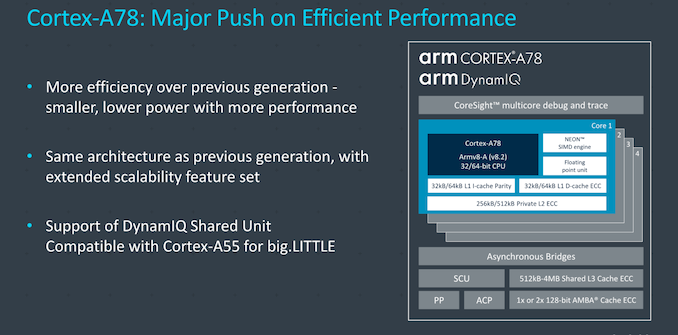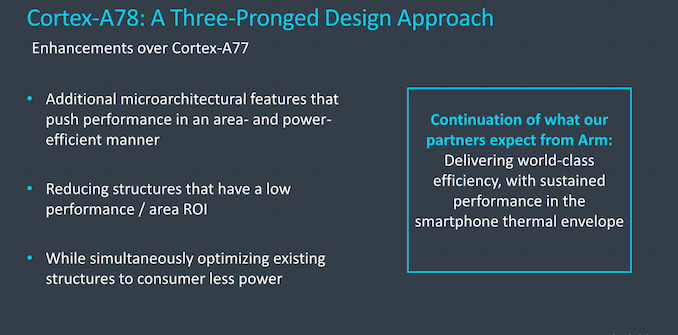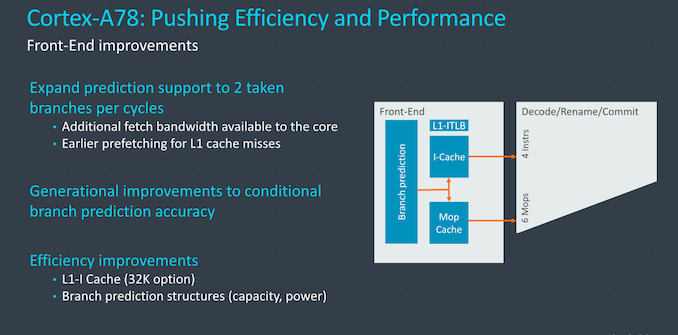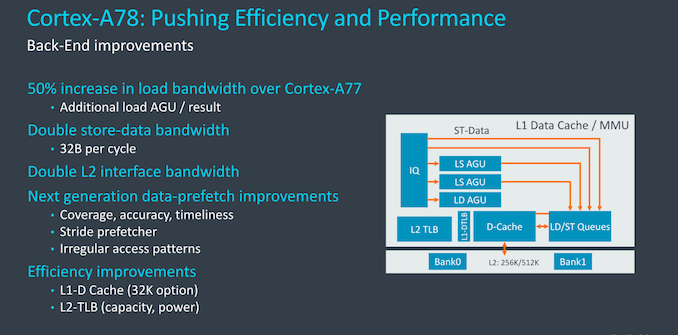Arm's New Cortex-A78 and Cortex-X1 Microarchitectures: An Efficiency and Performance Divergence
by Andrei Frumusanu on May 26, 2020 9:00 AM EST- Posted in
- SoCs
- CPUs
- Arm
- Smartphones
- Mobile
- GPUs
- Cortex
- Cortex A78
- Cortex X1
- Mali G78
The Cortex-A78 Micro-architecture: PPA Focused
The new Cortex-A78 had been on Arm’s roadmaps for a few years now, and we have been expecting the design to represent the smallest generational microarchitectural jump in Arm’s new Austin family. As the third iteration of Arm's Austin core designs, A78 follows the sizable 25-30% IPC improvements that Arm delivered on the Cortex-A76 and A77, which is to say that Arm has already picked a lot of the low-hanging fruit in refining their Austin core.
As the new A78 now finds itself part of a sibling pairing along side the higher performance X1 CPU, we naturally see the biggest focus of this particular microarchitecture being on improving the PPA of the design. Arm’s goals were reasonable performance improvements, balanced with reduced power usage and maintaining or reducing the area of the core.
It’s still an Arm v8.2 CPU, sharing ISA compatibility with the Cortex-A55 CPU for which it is meant to be paired with in a DynamIQ cluster. We see similar scaling possibilities here, with up to 4 cores per DSU, with an L3 cache scaling up to 4MB in Arm’s projected average target designs.
Microarchitectural improvements of the core are found throughout the design. On the front-end, the biggest change has been on the part of the branch predictor, which now is able to process up to two taken branches per cycle. Last year, the Cortex-A77 had introduced as secondary branch execution unit in the back-end, however the actual branch unit on the front-end still only resolved a single branch per cycle.
The A78 is now able to concurrently resolve two predictions per cycle, vastly increasing the throughput on this part of the core and better able to recover from branch mispredictions and resulting pipeline bubbles further downstream in the core. Arm claims their microarchitecture is very branch prediction driven so the improvements here add a lot to the generational improvements of the core. Naturally, the branch predictors themselves have also been improved in terms of their accuracy, which is an ongoing effort with every new generation.
Arm focused on a slew of different aspects of the front-end to improve power efficiency. On the part of the L1I cache, we're now seeing the company offer a 32KB implementation option for vendors, allowing customers to reduce area of the core for a small hit on performance, but with gains in efficiency. Other changes were done to some structures of the branch predictors, where the company downsized some of the low return-on-investment blocks which had a larger cost on area and power, but didn’t have an as large impact on performance.
The Mop cache on the Cortex-A78 remained the same as on the A77, housing up to 1500 already decoded macro-ops. The bandwidth from the front-end to the mid-core is the same as on the A77, with an up to 4-wide instruction decoder and fetching up to 6 instructions from the macro-op cache to the rename stage, bypassing the decoder.
In the mid-core and execution pipelines, most of the work was done in regards to improving the area and power efficiency of the design. We’re now seeing more cases of instruction fusions taking place, which helps not only performance of the core, but also power efficiency as it now uses up less resources for the same amount of work, using less energy.
The issue queues have also seen quite larger changes in their designs. Arm explains that in any OOO-core these are quite power-hungry features, and the designers have made some good power efficiency improvements in these structures, although not detailing any specifics of the changes.
Register renaming structures and register files have also been optimized for efficiency, sometimes seeing a reduction of their sizes. The register files in particular have seen a redesign in the density of the entries they’re able to house, packing in more data in the same amount of space, enabling the designers to reduce the structures’ overall size without reducing their capabilities or performance.
On the re-order-buffer side, although the capacity remains the same at 160 entries, the new A78 improves power efficiency and the density of instructions that can be packed into the buffer, increasing the instructions per unit area of the structure.
Arm has also fine-tuned the out-of-order window size of the A78, actually reducing it in comparison to the A77. The explanation here is that larger window sizes generally do not deliver a good return on investment when scaling up in size, and the goal of the A78 is to maximize efficiency. It’s to be noted that the OOO-window here not solely refers to the ROB which has remained the same size, Arm here employs different buffers, queues, and structures which enable OOO operation, and it’s likely in these blocks where we’re seeing a reduction in capacity.
On the diagram, here we see Arm slightly changing its descriptions on the dispatch stage, disclosing a dispatch bandwidth of 6 macro-ops (Mops) per cycle, whereas last year the company had described the A77 as dispatching 10 µops. The apples-to-apples comparison here is that the new A78 increases the dispatch bandwidth to 12 µops per cycle on the dispatch end, allowing for a wider execution core which houses some new capabilities.
On the integer execution side, the only big addition has been the upgrade of one of the ALUs to a more complex pipeline which now also handles multiplications, essentially doubling the integer MUL bandwidth of the core.
The rest of the execution units have seen very little to no changes this generation, and are pretty much in line with what we’ve already seen in the Cortex-A77. It’s only next year where we expect to see a bigger change in the execution units of Arm’s cores.
On the back-end of the core and the memory subsystem, we actually find some larger changes for performance improvements. The first big change is the addition of a new load AGU which complements the two-existing load/store AGUs. This doesn’t change the store operations executed per cycle, but gives the core a 50% increase in load bandwidth.
The interface bandwidth from the LD/ST queues to the L1D cache has been doubled from 16 bytes per cycle to 32 bytes per cycle, and the core’s interfaces to the L2 has also been doubled up in terms of both its read and write bandwidth.
Arm seemingly already has some of the most advanced prefetchers in the industry, and here they claim the A78 further improves the designs both in terms of their memory area coverage, accuracy and timeliness. Timeliness here refers to their quick latching on onto emerging patterns and bringing in the data into the lower caches as fast as possible. You also don’t watch the prefetchers to kick in too early or too late, such as needlessly prefetching data that’s not going to be used for some time.
Much like the L1I cache, the A78 now also offers an 32KB L1D option that gives vendors the choice to configure a smaller core setup. The L2 TLB has also been reduced from 1280 to 1024 pages – this essentially improves the power efficiency of the structure whilst still retaining enough entries to allow for complete coverage of a 4MB L3 cache, still minimizing access latency in that regard.
Overall, the Cortex-A78’s microarchitectural disclosures might sound surprising if the core were to be presented in a vacuum, as we’re seeing quite a lot of mentions of reduced structure sizes and overall compromises being made in order to maximize energy efficiency. Naturally this makes sense given that the Cortex-X1 focuses on performance…















192 Comments
View All Comments
DanNeely - Tuesday, May 26, 2020 - link
having gotten to page 4 in the article, the explanation is that ARMs slides as used on the first page suck. The 20% from A77-A78 is +7% architecture, and +13% 5nm instead of 7nm. The 30% from A77-X1 is entirely architecture; that in turn implies that upcoming X1 chips should be about 40-45% faster than current A77 ones.AIUI It's still going to be falling short of what Apple's doing (and not just because the A55 little cores are getting really dated); but is a badly needed narrowing of the gap.
ichaya - Tuesday, May 26, 2020 - link
40-45% on appropriately less die area than Apple and you've got something competitive atleast.DanNeely - Tuesday, May 26, 2020 - link
in terms of engineering prowess certainly; but not in terms of letting Samsung/etc finally design smartphones and tablets that are as fast as their rivals from Apple. Assuming the product plays out in retail, in another 2 or 3 years when I look to replace my S10 I'll probably get something with an X core in it; but I really hope that they'll widen the performance uplift vs their more general purpose cores by then.Raqia - Tuesday, May 26, 2020 - link
The existing A77's are already very impressive in terms of PPA, I would consider them as impressive as Apple's big cores taken as a whole. (The small cores are another story since the major uplift from the A13...) A lot of Android vendors value area in particular since they integrate modems on die whereas Apple does not; this drives a lot of value and cost savings for customers.CiccioB - Tuesday, May 26, 2020 - link
If Samsung really wants to create a phone/tablet as fast as an Apple one it should first concentrate more on SW optimizations. Apple puts a lot of efforts in that. It's not only a question who makes the bigger core.See the comparison of Samsung crappy phones with other Android ones using much more optimized and less bloated version of the OS. They are good for benchmarking with all those cores and MHz (and tricks on turbo spped for benchmark apps), but in real life Samsung phones are slower than they could be do to low optimizations.
Wilco1 - Tuesday, May 26, 2020 - link
Bingo! Adding a big core that does well in benchmarks is not a good solution. Improving browser performance with software optimization can be far more effective.armchair_architect - Wednesday, May 27, 2020 - link
@Wilco1 I am afraid you only the SW part of the equation here.Again X1 is not only good in benchmarks, being wide helps in that you can achieve same performance as last-gen by running at vastly lower frequency and voltage.
Thus power efficiency for all use cases that do not require max peak perf enjoy a huge power saving.
Wilco1 - Thursday, May 28, 2020 - link
You can't brute-force your way to performance or efficiency. If you can improve performance via software optimization, you take it any time over a faster core that gives the same gain but needs more power to run the unoptimized software.It's as simple as that.
armchair_architect - Thursday, May 28, 2020 - link
Obviously you would ideally need both SW optimization and faster CPUs.But again, power will not always be higher and higher power != higher energy usage.
Wilco1 - Thursday, May 28, 2020 - link
Absolutely. But the biggest issue in the Android world is software optimization and tuning, not CPU performance. Improving that would easily add up to a new CPU generation. The choice to switch to LLVM was stupid at the time, but even more so today since GCC has since moved further ahead of LLVM...Note all the evidence points to using smaller cores to improve power efficiency. You can see this on the perf/W estimates for SPEC - the A78 is almost twice as efficient as A13 while achieving 74% of the performance.